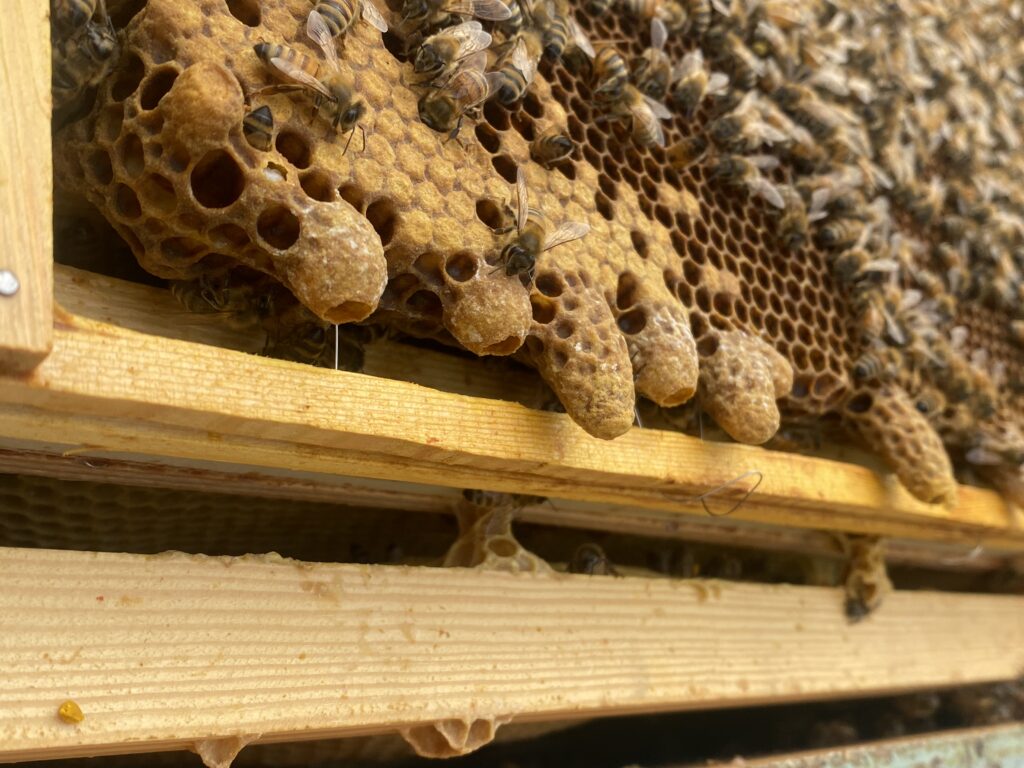Beekeeping is a constant process of thought and reflection on what might have gone wrong. Funny how we often spend less time thinking about what went right!

Most beekeepers mark their queens. When you’re looking for one bee in a colony of 50,000+ it’s a great help although so long as there’s eggs, you don’t need to actually see her. Two weeks ago I spotted the most beautiful black queen and left a neat red dot on her thorax. The following week she had ink all over her wings. I’m thinking she must have brushed against other bees before it was dry. It doesn’t seem to have harmed her and she’s now really easy to spot!

Two weeks ago the strongest hive was in the final stages of preparing to swarm. Books and beekeepers say a capped queen cell means the colony has already gone, taking the old queen with up to 75% of the bees with her. There were eleven queen cells, several capped, but also saw eggs so I knew she’d been active in the past three days. I’ve never seen this queen. She’s shy and likes to hide, but the colony clearly wanted to swarm so intervention was required.
It took a while to decide what to do. This year I’m trying not to text my mentor every time I have a problem. Instead, I’m trying to sort it out myself. It was easier before!

I made up two small nucs with some of the best queen cells. Again the books and beekeepers recommend finding the queen and putting her in the nuc, leaving her colony to raise a new one. I’ve done it the other way around a few times and it’s nearly always worked,. These nucs are now being left alone for a couple of weeks to get establish.
Last week, I returned to the donor hive. No new swarm cells, which was good, but a single capped queen cell was in the centre of the outer frame of stores.

There are different types of queen cells and a beekeeper has to try and decide what’s going on.
- Swarm cells – often a dozen or more, they frequently hang down from the bottom of the frame and are a sign the colony is running out of space.
- Supercedure cells – usually 1-4 and often in the centre of a frame, they signal something is wrong with the present queen; she’s ageing, diseased or has run out of sperm, and the bees are replacing her.
- Emergency cells – often 1-2, usually in the centre of a frame and a sign the queen has died.
When I started beekeeping I quickly learned the truth of the saying ‘ask three beekeepers and get five different replies‘. The outer frame of stores is an unusual place to find a queen cell but the bees have been taking care of themselves for millennia and we have to learn to trust them to know what they’re doing.

I was sure it wasn’t a swarm cell. This left supercedure or emergency options. Either way, they were replacing their queen so I left the cell alone.
This week, the cell was uncapped suggesting they now had a virgin queen, waiting for better weather so she could go on a mating flight. Again, I left the hive alone. They have two super boxes with plenty of storage space. There’s also new frames in the brood box to replace those taken out when I made nucs with their swarm cells.

This inspection was relatively quick.
I’m still leaving alone the nucs I made with swarm cells two weeks ago.
The nucs housing the small winter clusters are thriving. Their queens are in full-on laying mode and they’ll soon be ready to go back into full-size hives.

The final hive was a bit irritable towards the end of last summer and I got plenty of stings. This year they seem fine again and their queen is laying well. No swarm cells yet but I need to be prepared. I can perform a preventative swarm method, either a Pagden or a Demaree or alternatively, wait for them to tell me they want to go, then make a few more splits to increase colony numbers. At the moment, I’m not sure which but I have a week to decide.

This weekend I also helped out at the local Beekeeping Association Open Day. Thirty people attended, all interested in finding out about the bees. Taking part in an event like this is one of the best ways to discover how you feel standing in the middle of thousands of flying bees. It was a chilly morning so the bees were lively. I got a sting through my veil but I enjoyed the session.
For anyone interested in beekeeping, I’d recommend looking for your local association and seeing if they have any similar events planned. Beverley Beekeepers demonstrate how to light a smoker and then a beekeeper will talk everyone through an inspection with one of the Association’s hives.
The more I learn about bees, the more there is to discover. It’s a permanent learning curve. Bees do their own thing but once you learn the basics about reading a hive and its frames, then keeping bees can be fascinating and sometimes magical. I never get tired of watching them.
